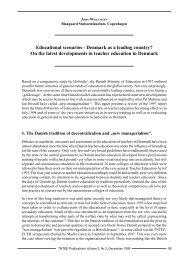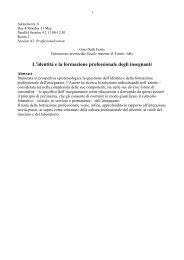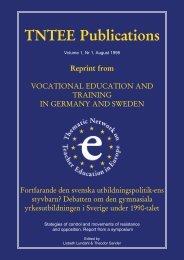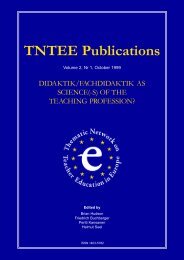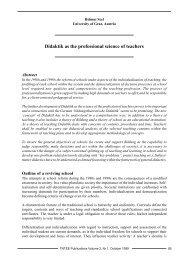Didaktik/Fachdidaktik as Science(-s) of the Teaching ... - tntee
Didaktik/Fachdidaktik as Science(-s) of the Teaching ... - tntee
Didaktik/Fachdidaktik as Science(-s) of the Teaching ... - tntee
- TAGS
- teaching
- tntee
- tntee.umu.se
Create successful ePaper yourself
Turn your PDF publications into a flip-book with our unique Google optimized e-Paper software.
78<br />
<strong>Didaktik</strong>/fachdidaktik <strong>as</strong> integrative transformation science(-s)<br />
have to be transformed into more specified aims for teaching and learning (transformation 1).<br />
Concepts such <strong>as</strong> Bildung may have important roles to play in this transformation process (cf.<br />
Klafki 1992 and his concept <strong>of</strong> Allgemeinbildung oriented on key-problems <strong>of</strong> society).<br />
Propositionally formulated and systematically structured knowledge <strong>of</strong> particular academic<br />
disciplines h<strong>as</strong> to be transformed into knowledge structures. Both transformations within <strong>the</strong><br />
first transformation process may not be seen independently. While many interactions exist<br />
between “general aims <strong>of</strong> society” and “(scientific) knowledge” and its production, dialogues<br />
between representatives <strong>of</strong> society (democratic authorities) and <strong>the</strong> DF research community<br />
may be seen <strong>as</strong> imperative to <strong>the</strong> transformation necessary. As regards <strong>the</strong> transformation <strong>of</strong><br />
“(scientific) knowledge” into knowledge structures, <strong>the</strong> dialogue between representatives <strong>of</strong><br />
<strong>the</strong> different academic disciplines and <strong>the</strong> DF research community may be seen <strong>as</strong> a necessary<br />
condition.<br />
(d) “Specified aims” and “knowledge structures” may be seen <strong>the</strong>n <strong>as</strong> <strong>the</strong> second level <strong>of</strong> DF.<br />
They form a potential pool <strong>of</strong> aims and knowledge structures to become <strong>the</strong> subjects <strong>of</strong> teaching,<br />
studying and learning.<br />
(e) In a second transformation process specified aims and knowledge structures have to be integrated<br />
to possible “<strong>the</strong>matic units” or “<strong>the</strong>mes” (<strong>the</strong>matische Lernangebote) for teaching, studying<br />
and learning. Considering<br />
• on <strong>the</strong> one hand <strong>the</strong> many aims possible and <strong>the</strong> huge amount <strong>of</strong> knowledge structures<br />
available and<br />
• on <strong>the</strong> o<strong>the</strong>r hand <strong>the</strong> limited resources, human information processing capacity and<br />
time available<br />
transformations <strong>of</strong> type 2 are indispensable. Transformation 2 h<strong>as</strong> to result in a justifiable pool<br />
<strong>of</strong> “<strong>the</strong>mes” or <strong>the</strong>matic units.<br />
(f) “Thematic units” or “<strong>the</strong>mes” conceived <strong>as</strong> coherent sets <strong>of</strong> aims and content may be seen <strong>as</strong><br />
level 3 <strong>of</strong> DF.<br />
(g) In a third transformation process “<strong>the</strong>matic units” are transformed into concrete learning<br />
situations (level 4). Learning situations may be characterized by <strong>the</strong> following components:<br />
• context,<br />
• actors (e.g. teachers, learners), <strong>the</strong>ir characteristics and actions,<br />
• aims and objectives,<br />
• content/substance,<br />
• teaching/studying/learning strategies, and<br />
• media.<br />
(h) Having categorized “general aims <strong>of</strong> society” and “(scientific) knowledge” at <strong>the</strong> first level,<br />
and “learning situations” at <strong>the</strong> fourth does not imply superiority <strong>of</strong> <strong>the</strong> first or less relevance<br />
to “learning situations”. The model <strong>of</strong> DF <strong>as</strong> integrative transformation science intends to<br />
outline <strong>the</strong> integrated nature <strong>of</strong> <strong>the</strong> phenomenon under discussion which cannot be reduced to<br />
one or <strong>the</strong> o<strong>the</strong>r category/level or transformation.<br />
The model <strong>of</strong> DF outlined might have enormous impact on restructuring TE (e.g. focus on teaching,<br />
studying and learning instead <strong>of</strong> academic disciplines), <strong>the</strong> organization <strong>of</strong> teaching and learning in<br />
schools (e.g focus on learning situations and <strong>the</strong>matic units/problem are<strong>as</strong> instead <strong>of</strong> subject-matter<br />
structures) and <strong>the</strong> teaching pr<strong>of</strong>ession (e.g. solid scientifically validated knowledge and practices<br />
which could contribute to empowerment and reduction <strong>of</strong> dependence on external and political<br />
control <strong>as</strong> well <strong>as</strong> on non-teaching related academic disciplines). Additionally, DF conceived <strong>as</strong> an<br />
integrative transformation science could open up new opportunities to tackle ano<strong>the</strong>r <strong>of</strong>ten neglected<br />
problem <strong>of</strong> teaching and learning. It could provide a framework for <strong>the</strong> production <strong>of</strong> empirically<br />
validated teaching and learning technology/Veraenderungswissen (e.g. netb<strong>as</strong>ed learning<br />
environments and s<strong>of</strong>tware) comparable to treatments/medicines in <strong>the</strong> medical sciences.<br />
TNTEE Publications Volume 2, Nr 1, October 1999



